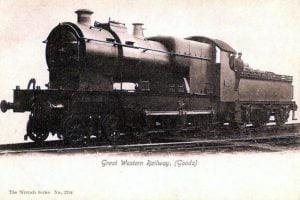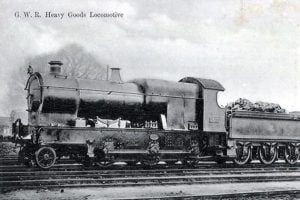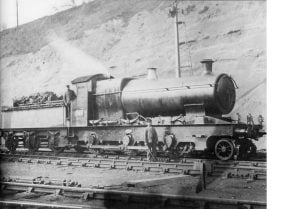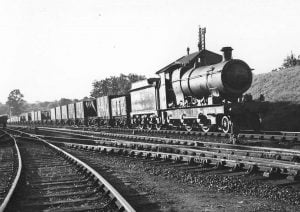This week’s Lost Class article will feature two class, the 2602 class, and the 2600 ‘Aberdare class.
Both classes are similar in design, with the 2600 class succeeding the 2602 class. Once looking at the history of both classes, we will look at the chances of seeing one in the 21st century.
GWR 2602 Class
The period between 1897 and 1903 saw many interesting and unorthodox designs of locomotives emerging from Swindon Works. This time saw Churchward as William Dean’s Chief Assistant.
Although Dean was official in charge, Churchward had a large influence in the design work of new engines, as Dean’s declining health meant he was not fully able to carry out his role as Locomotive Superintendent.
The 2602 class featured two notable features: both outside and inside main frame (outside for the 3 sets of coupled wheels and inside for the bogie / leading truck) and sandbox placed on the boiler barrel. Both of these formed unique looking locomotives.

In 1899, prototypes No.2601 and No.2602 were constructed, with the main difference being the wheel arrangement, with 2601 having a 4-6-0 configuration and 2602 having a 2-6-0 configuration. Four years later, another eight locomotives were built with the 2-6-0 wheel arrangement.
Basic dimensions for the class include 2-6-0 wheel arrangement (coupled wheels – 4 foot (ft) 7 1/2 inch (in) and leading wheels – 2ft 8in), boiler pressed at 180 lbf/in2 and two cylinders (inside at 19in diameter and 28in stroke).
Issues in Service

The 2602 class were experimental, with Churchward being keen to test different ideas. This can be seen in the boiler design, with its high pressure for the time and long combustion chamber. Both causing problems in service. The solid crank axles were known to fracture due to the long piston stroke of 28 ins.
Withdrawal
With these issues, the decision was made to withdraw the whole class of 10 engines in 1906. Some of the numbers were recycled and used on the Aberdare Class, with the possibility of some parts also be retained.
Preservation
With the class being broken up so soon after being built, with little to no effort made in fixing their faults, I think its safe to say that it’s highly unlikely we will see a new 2602 class built for heritage use.
2600 Class
Although similar in design to the 2602 class and being drawn up & constructed around the same time, a major influence for the class came from the 3300 and 4120 classes. These were both express passenger engine types, therefore having a 4-4-0 wheel arrangement. The Aberdares were designed for freight work, featuring the 2-6-0 configuration.

A prototype, No.33, was built in 1900. The engine followed more conventional practices, such as full-length outside mainframe. The basic dimensions for the class include 2-6-0 wheel arrangement (coupled wheels – 4ft 7 1/2in and leading wheels – 2ft 8in), boiler pressed at 200 lbf/in2 and two cylinders (inside at 18in diameter and 26in stroke). The differences in dimensions from the 2602 class might be an improved on them, especially with the reduced length of stroke by 2in.
Production Series
Due to the 2602 class occupying the next chronological numbers for the 2600 class, the decisions was made to start at No.2621 after No.2600. The full order can be found below:
- Lot 128, 1900 – No.2600 – 1 engine
- Lot 131, 1901 – No.2621 to 2640 – 20 engines
- Lot 133, 1901-02 – No.2641 to 2660 – 20 engines
- Lot 135, 1902 – No.2661 to 2680 – 20 engines
- Lot 123, 1903 – No.2611 to 2620 – 20 engines
- Lot 156, 1906 – No.2601 – 1 engine
- Lot 166, 1906-07 – No.2602 to 2610 – 9 engines

Performance in Service
The class was named after one of the destinations they were built for hauling trains between, Aberdare. The 2600s were allocated to the coal trains travelling from the coal mines around Aberdare to Swindon, where the works used the coal. Unfortunately, there is little information on how well they carried out these duties, but with withdrawals not starting until 1934, the class must have adequate for the job. The biggest issues were the steam reverser having a habit to drift. Keeping a close eye on the reverser enabled it to be adjusted when it changed unexpectedly.
Decline and Withdrawal

The early 1930s saw the introduction of the large 2-8-2 tank engines, which succeeded the 2600s from the coal traffic out of Aberdare. This began the gradual withdrawal and scrapping of the class. Several members survived to the formation of British Railways, but in October 1949 when aged 47 years old, No.2667 was the final member of the class to be removed from service.
Preservation
With members of the 2600 ‘Aberdares’ class reaching 40 years old, they were clearly brilliant engines. To top this, the class was some of the first to have Churchward’s influence. Combined with Dean’s own practices, the engines formed looked both modern and dated, tidy in design but allocated to heavy, dirty work.
This is definitely a class which would be good for heritage trains, but with many popular projects building various designs and types of lost engines, some more suited for 21st century needs and wants, it may be a while before we see the start of the 81st 2600 ‘Aberdare’ class.
We hope you have enjoyed reading this week’s Lost Class article. We’ll be back next week with another Class Information featuring an LNER designed locomotive class. In the meantime, here’s last week’s Sole Survivor based on the LNER Peppercorn A2 class, to get you in the LNER mood.
Where Next?
News Homepage
For the Latest Railway News
RailAdvent Online Shop
Framed Prints, DVD’s / Blu-Ray’s and more
LocoStop – The RailAdvent Community
Come and share your railway pictures






Responses